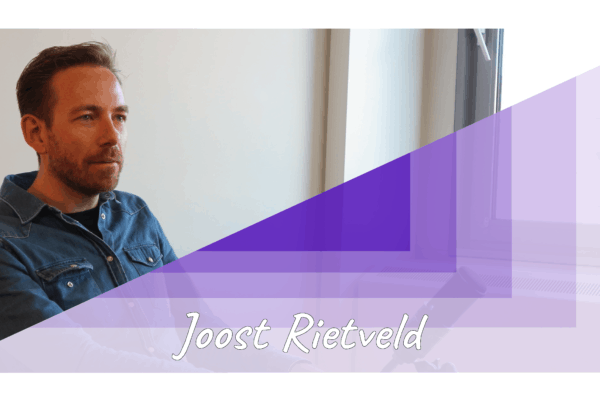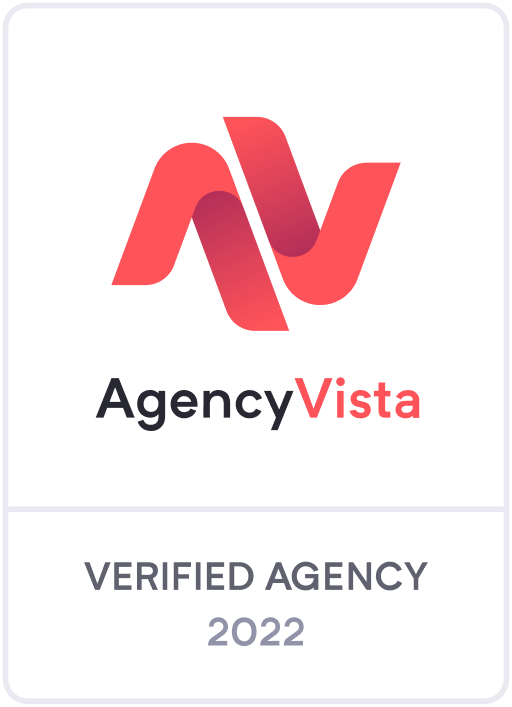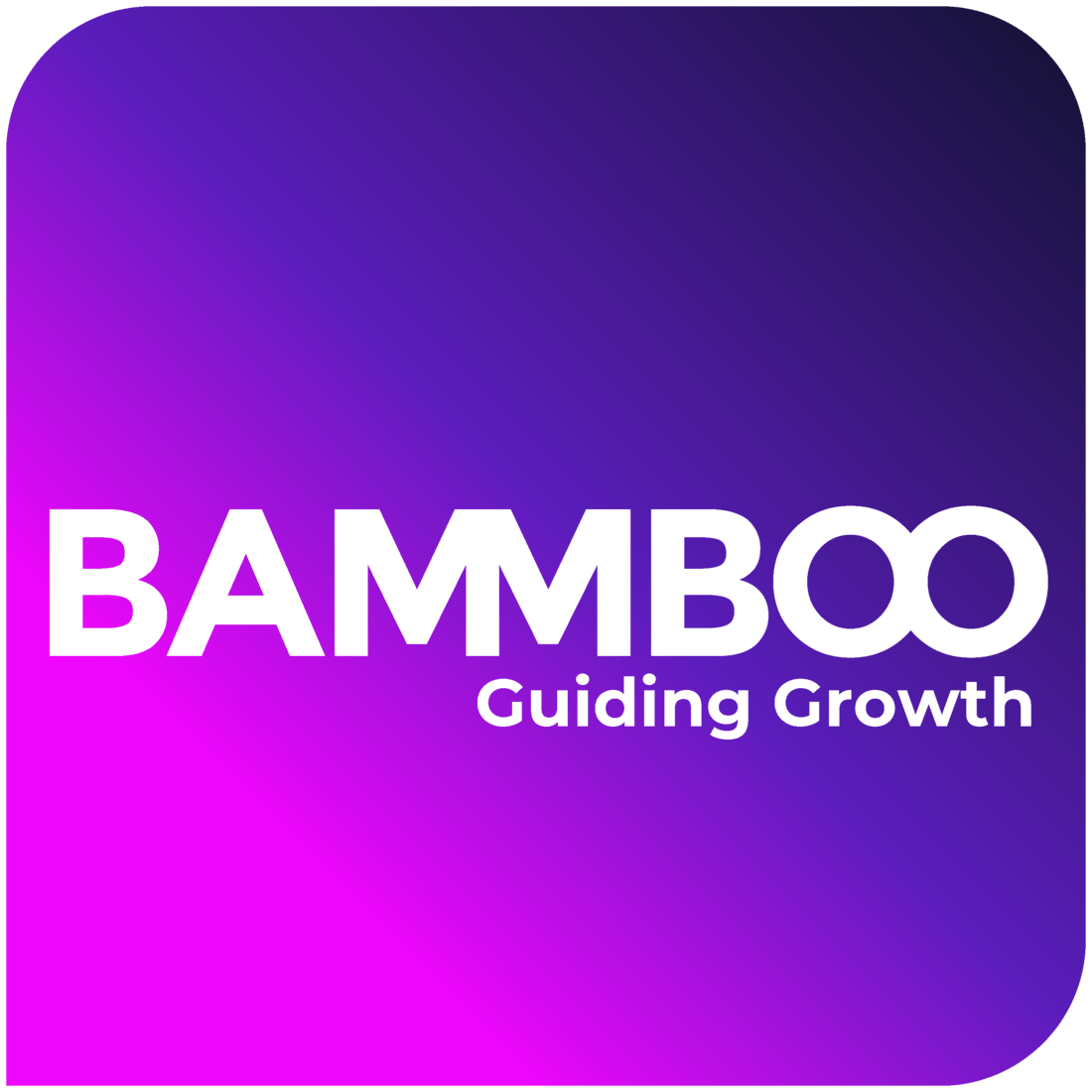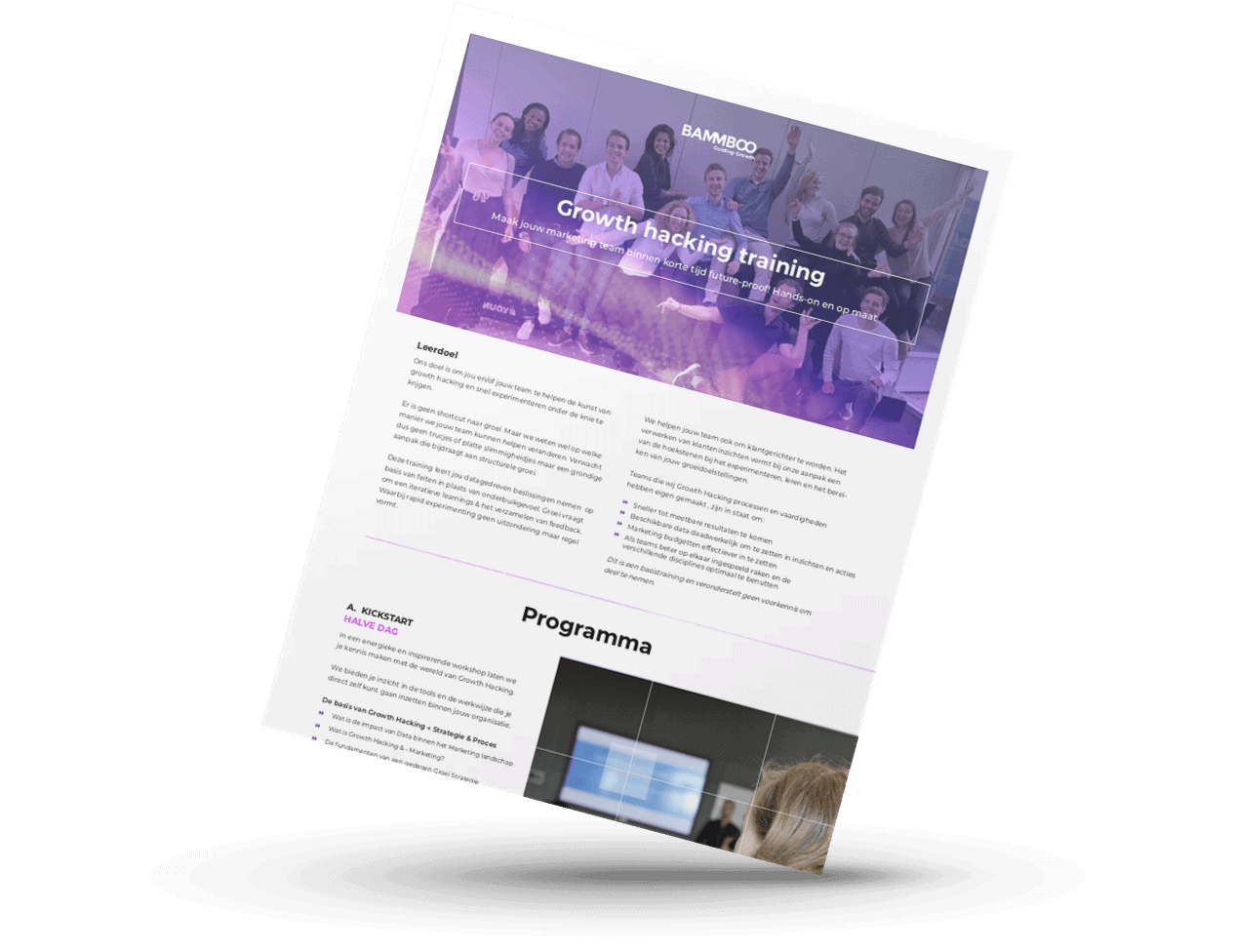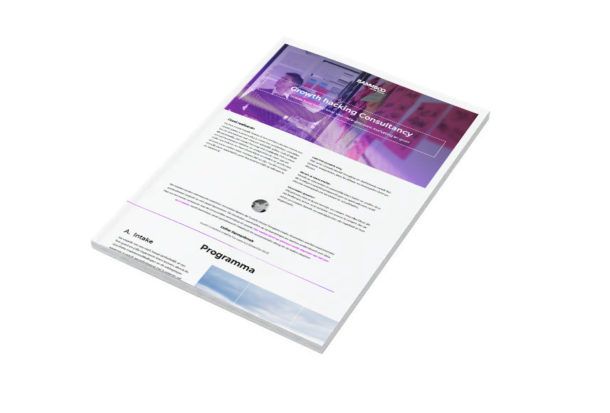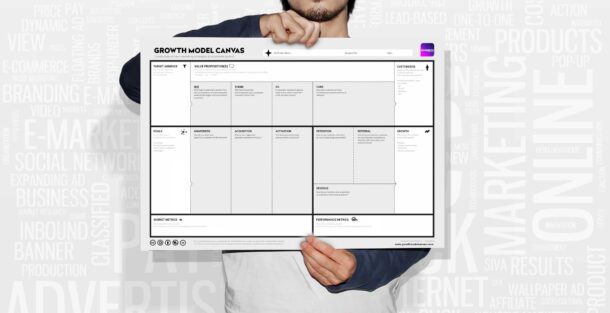Growth and value creation in a complex playing field
Complex, rapidly changing and highly specialized.
This is the world we’re operating in at the moment.
Marketing, product development and innovation are becoming more and more challenging for business leaders. Customer journeys are becoming more complex. The number of available and necessary tools for managing marketing, product, activation, and retention is growing exponentially. How do you maintain the helicopter overview in this ocean of tools and processes? And more importantly, how do you keep focusing on what you need to be focusing on?
In the end, of course, it’s all about sustainable growth and creating value. Right?
The traditional ways of realizing growth – focusing purely on marketing, sales or product – no longer work. And by now, deploying the once-innovative Growth Hacking as a set of tricks or tools helps only to a very limited extent. If you want to be successful in the long run, what’s necessary is creating a vision for and an approach to Continuous Value Creation, from multiple perspectives simultaneously.
We’re happy to share our vision and approach for this with you. Let’s dive in.
What the market demands
Yesterday’s hyped solutions are already obsolete today. Are you still on Whatsapp? The cool kids with a greater need for independence and privacy have already been on Telegram and Discord for some time.Facebook? TikTok. Tinder? How about video profiles on Snack or Lollipop?
Evolving and changing customer needs require continuous feedback and insights into those needs. Combined with the rapid proliferation of competing alternatives alongside yours, this demands speed, creativity, and effectiveness in the way you innovate your business.
As the person responsible for the growth and development of your company, you actually have to manage all the different perspectives, disciplines, processes, and trends in this playing field simultaneously. Yeah, that’s quite a challenge. How do you tackle this?
The new necessity: continuous renewal
As the person responsible for growth in your business today, what you need is a new, more dynamic, approach. An approach that understands different perspectives in the customer journey and the synergies between different ways of working; growing from marketing, sales and/or product. Of course, the wheels of your business have to keep turning. But just relying on your current operations is simply not going to suffice anymore.
Structurally discovering, developing, and launching new propositions, aligned with your vision, is essential in these times. And of course, continually improving your existing propositions. The goal being to remain relevant to current or new target groups.

After all, if you don’t focus on this, one of your competitors will.
This requires ideas. Ideas for new propositions, but perhaps more importantly, for the further development of your existing products and services.
And, to get from idea to scalable, sustainable growth as quickly as possible – you also need a sustainable and methodical approach. This domain and this approach are what we call Continuous Value Creation.
Read on to learn more about how this works, and how it plays out in practice.
From idea to successful business: how value becomes tangible and contributes to growth
Solving a new need, or a newly identified problem. Or improving an existing solution thanks to new insights. It often starts with a moment of inspiration in the shower. A brainstorming session worked out on the back of a napkin or a coaster. An aha moment in a conversation with a customer. A brainfart.
A successful product or service is always based on a good idea. And more often than that, on dozens of good ideas.
Because to grow from brainfarts or brainstorms into a successful product, service, or business, ideas inevitably fail. And to get from an idea to a success, an idea has to move through several phases.
Design Thinking and Growth Hacking as pillars for growth and scalability
BAMMBOO was one of the first Growth Hacking agencies in Europe. With the goal to help organizations grow, along with a vision and a process for continuous growth and value creation. Our experience over the past five years has made us realize that Growth Hacking as a methodology alone is fairly limited.
That is to say: over the entire continuum from idea to scalable growth, you need to be continuously validating assumptions and hypotheses. Where in the beginning you do this through Design Thinking, and later on through Growth Hacking.

We call this the process of Continuous Value Creation. Note that this is not a linear continuum. It is a quest of continuous validation of assumptions and hypotheses. In which the value you want to deliver is repeatedly tested with the user:
Do (potential) customers experience this problem themselves? Do they see the added value of the product or service we have in mind? Does the product meet the expectations of the people for whom we have intended it?
Design Thinking, Growth Hacking, and Feedback
Growth and the continuous creation of value consist of two important phases: the Idea Phase and the Growth Phase. Design Thinking and Growth Hacking are the methods you use to achieve scalable growth in the specific phases of this growth cycle.
You use Design Thinking in the Idea Phase: in service of designing a proposition by discovering customer value (based on a problem or need). While Growth Hacking is about accelerating growth; catalyzing and improving value (where possible very quickly) into a scalable proposition. Both have equally important roles as they complement each other on the road towards growth.
Feedback is the artery through which the continuous flow of insights contributes to the process of value creation. This is what Continuous Value Creation looks like when we visualize it as a continuous process:
Continuous Value Creation as a process
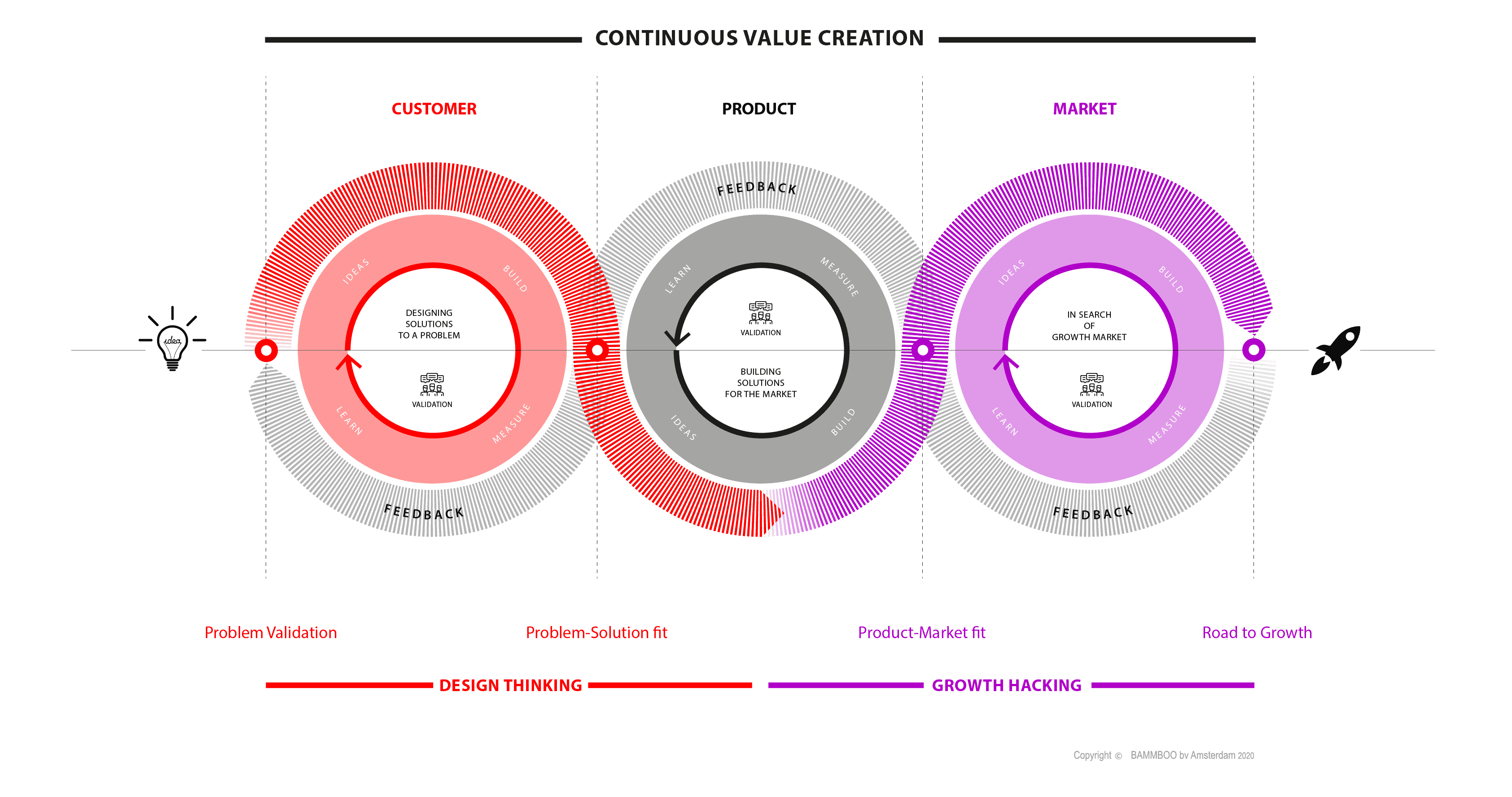
We distinguish two phases: the Idea Phase (Design Thinking, in red), and the Growth Phase (Growth Hacking, in purple). Additionally, we distinguish three perspectives on value creation; the customer perspective, the product perspective, and the market perspective:
- The customer perspective (the left circle in the model) is about validating a customer problem, and designing a solution.
- The product perspective (middle circle) is about developing a product, based on the solution, for which potential customers are willing to pay.
- The market perspective (right) is about validating the growth path. What are the channels to reach the target audience? With what message? And how do you scale the proposition?
Finally, the three circles are connected by a repeating feedback loop. This is because it’s all about fluid connection and collaboration, from the three different perspectives – and the corresponding teams.
Now, what exactly happens in the two phases in this model for continuous value creation?
The Idea Phase: Design Thinking, Customer Circle
When you have a new idea based on a customer problem, need, or your own insights, and want to bring this idea to a validated solution, you find yourself in the idea phase. This phase is characterized by qualitative research and data collection with small focus groups. Iteration here consists of problem identification and determining the characteristics of your ideal customer group or persona. The key process you use here is Design Thinking.
What is Design Thinking?
Design Thinking is a process for finding problem-solution fit. Design Thinking is holistic, but emphasizes the need for hands-on prototyping and testing. In particular, the method focuses on testing the “why” or the “Minimum Viable Concept” with actual users.
In practice, you use Design Thinking to validate each problem, and to assess the desirability, feasibility and viability of all potential solutions.
The Growth Phase: Growth Hacking, Market Circle
Ok. The desirability, feasibility and viability of your potential solution have all been validated with actual flesh and blood people in your target group.
When you then have a validated solution available in the form of a product or service (the proposition) you want to validate whether your target group will actually buy this solution. You now find yourself in what we call the ‘Growth Phase’. Here you validate the channels through which you can best reach your target group, and you further outline your road to growth. The process you use in this phase in particular, is Growth Hacking.
What is Growth Hacking?
Growth Hacking is a method based on conducting data-driven experiments with the goal of finding growth (opportunities).
The process revolves around continuously testing and validating hypotheses. These hypotheses are derived from the insights gained from both quantitative and qualitative data analysis. So: numbers
and conversations with actual human beings.
Growth Hacking combines three domains to accelerate growth: product-led growth, marketing-led growth and sales-led growth. Short feedback loops in all three domains ensure continuous value creation in all phases of your company’s development.
Growth Hacking is not a trick. If used correctly – it is a key driver for rapid, sustainable growth and continuous value creation.
So, what does our vision and approach to Continuous Value Creation deliver in practice?
Sustainable growth and continuous value creation
Innovation is not a one-time exercise. At least, not if you want to be and remain successful in the longer term.
When you use Growth Hacking alongside Design Thinking in a continuous process of value creation, you will actually begin to see that the process of innovation and improvement is indeed infinite. Or at least, as infinite as your business itself.
Again, it’s not just about inventing and adding completely new propositions. If you’re applying this approach the way we see it, you’re also constantly optimizing your existing business, products, and services.
This is how companies can achieve growth not only in the short term, but more importantly, sustainably and in the long term: with a focus on continuous value creation, validated at every step by the actual customer.
Continuous Value Creation in practice

At BAMMBOO, we help our clients find the fastest, most effective and most reliable path to sustainable growth and continuous value creation. We do this through an approach across four steps (which can also be used separately):
- Growth Strategy Identifying opportunities and outlining a growth strategy (using our Growth Model Canvas)
- Data Services Mapping and visualizing data that is translated into insights and growth opportunities. We offer customized dashboards to make this easier and more seamless.
- Growth Sprints We prioritize the above insights and growth opportunities and translate them into a growth plan (roadmap). And we help you implement and validate this growth plan.
- Growth Training Training employees with the right mindset, skillset, and toolset to be able to realize sustainable growth and continuous value creation independently.
Now, to what extent is our own value validated by the people we set out to help in the first place? What does all this help our customers achieve?
Enormously increased conversion ratios at lower costs, for example, like DELA. Or the validation of two propositions in one month, as at ARAG. But most importantly, at least in our view: the mindset, skills and methodologies to build sustainable growth by themselves, indefinitely. But don’t take it from us. Read what our clients themselves are saying, here
How do you view your next step toward growth?

We would love to hear how you see your organization’s next step in the journey towards continuous value creation and sustainable growth. We hope that this article has helped you take at least a small step forward. We would love to hear in the comments what your thoughts on the matter are.




